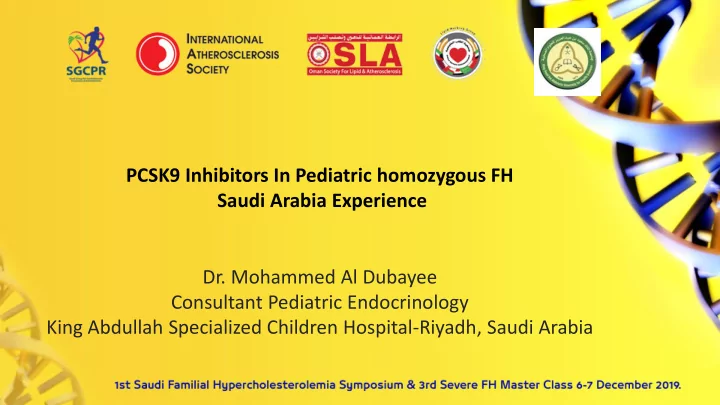

PCSK9 Inhibitors In Pediatric homozygous FH Saudi Arabia Experience Dr. Mohammed Al Dubayee Consultant Pediatric Endocrinology King Abdullah Specialized Children Hospital-Riyadh, Saudi Arabia
• Cholesterol filled foam cell 20-week-old fetus at autopsy • Fatty streak formation occurs in human fetal aortas and is enhanced by maternal hypercholesterolemia • Lipid deposits in most plaque cells included numerous non-membrane- bound deposits of variable electron density .(Am J Pathol97:327-358,1979)
Pathophysiology Molecular Defects in the Low-Density Lipoprotein Receptor Pathway • Deletion, missense, nonsense, and insertion mutations in (LDLR) affecting receptor function (>1,600 mutations reported to date); • Mutations in apolipoprotein B (APOB) that affect the ability of the ligand to recognize LDLR • Gain-of-function mutations in PCSK9 causing a reduction in LDLR on the cell surface; • Mutations in LDLR accessory protein 1 (LDLRAP1) causing improper placement of LDLR on the hepatocyte membrane
• Homozygous or compound heterozygous mutations in the LDLR gene (low-density lipoprotein receptor) encoding null or negative alleles that are associated with <2% of LDLR activity. • Homozygotes or compound heterozygotes for LDLR -defective alleles encoding LDLRs with 2% to 25% activity
Early intervention improves outcome • Kaplan – Meier curves of event-free survival in a cohort of 214 familial hypercholesterolaemia subjects treated from childhood compared with their parents
• Kaplan-Meier estimates of cumulative coronary heart disease-free survival among patients with familial hypercholesterolemia according to statin treatment.
Cox proportional hazards model with time-varying benefit from statin therapy comparing treated with untreated person-years for survival (A) and first major adverse cardiovascular event (MACE) (B) in patients with homozygous familial hypercholesterolemia, with year of birth fixed as the mean year of birth.
king Abdullah Specialist Children's Hospital KASCH • 14 pediatric HoFH, and more than 40 HeFH • Open specialized pediatric lipid clinic and adult lipid clinic • We offer LDL apheresis program • Cascade screening program, in house genetic testing done in KAIMRC • Multidisciplinary team approach
Middle East Advisory ry Panel FH Current Vascular Pharmacology, 2015, 13, 759-770
J Atheroscler Thromb, 2018; 25: 751-770.
• Patients with clinical ASCVD and substantially elevated LDL-C levels. Patients should be on maximally tolerated statin therapy (ideally with concomitant ezetimibe), or unable to tolerate three or more statins. • Familial hypercholesterolaemia (FH) patients without clinical ASCVD but with substantially elevated LDL-C levels • Patients should be on maximally tolerated statin therapy plus ezetimibe
• The TESLA (Trial Evaluating PCSK9 antibody in Subjects With LDL Receptor Abnormalities), proof-of-concept, part A study, performed in HoFH patients, showed reductions of 16.5% and 13.9% with evolocumab 420 mg Q4W and Q2W, respectively
Patients carrying the same mutations in homozygosity exhibited a heterogeneous response to the therapy ( 7.1% up to 56%), which, again, shows that the response to the medication is not consistant.
• The TAUSSIG study is an open-label study evaluating the long- term (5 years) efficacy and safety of evolocumab in HoFH patients with LDL-C levels not controlled by current lipid-lowering therapy (statin alone or in combination with ezetimibe). • An interim analysis showed that evolocumab produced a stable long-term reduction of LDL-C levels
European Heart Journal (2018) 39, 1169 – 1171
PCSK9 inhibitors is very effective and very tolerable option to reduce LDL cholesterol Based on current guidelines: • Patients with FH or ASCVD and statin resistance (on max dose) for additional LDL lowering effect. • In FH patients to avoid apheresis • 2nd line to addition of ezetimibe for statin intolerant patients
Thank you
Recommend
More recommend